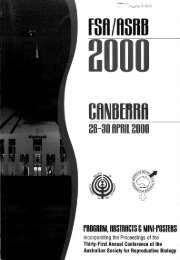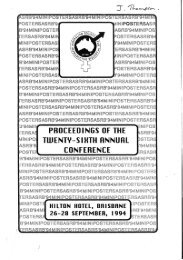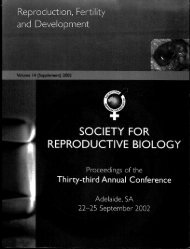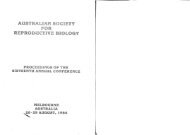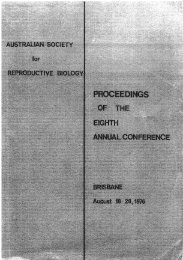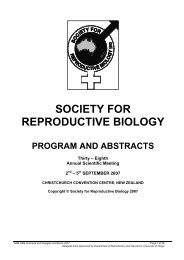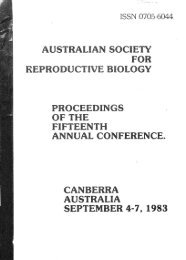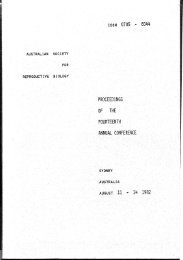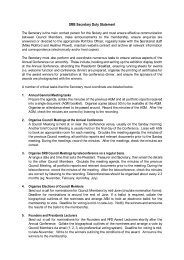N OCIETY' - the Society for Reproductive Biology
N OCIETY' - the Society for Reproductive Biology
N OCIETY' - the Society for Reproductive Biology
Create successful ePaper yourself
Turn your PDF publications into a flip-book with our unique Google optimized e-Paper software.
In vitro culture of brushtailed possum epididymal epi<strong>the</strong>lium and induction of epididymal spermmaturation in co-cultureMinjie Lin, Xiyi Zhang, Ray Murdoch and R. John AitkenMarsupial CRC, Dept of Biological Sciences, The University of Newcastle, NSW 2308, AustraliaIntroductionIn mammals, testicular sperm undergo a maturation processin <strong>the</strong> epididymis to acquire motility and <strong>the</strong> ability <strong>for</strong>fertilisation. However, sperm maturation in marsupials is amuch longer and more complex process than that of <strong>the</strong>ireu<strong>the</strong>rian counterparts (1). This process is poorlyunderstood, mainly because it cannot as yet be investigatedin vivo. Techniques of in vitro co-culture of sperm andepididymal cells have been developed in eu<strong>the</strong>rians during<strong>the</strong> past 2 decades, but not in marsupials species (2). Thispaper describes <strong>for</strong> <strong>the</strong> fITst time an in vitro cell culturesystem <strong>for</strong> a marsupial species, which supports epididymalepi<strong>the</strong>lial cells from <strong>the</strong> brushtailed possum, and evidence ofsperm maturation induced by <strong>the</strong> cultured epididymal cells.Materials & MethodsThe epididymis from 5 possums were used to establish <strong>the</strong>cell culture system with a medium modified from eu<strong>the</strong>riancultures (3,4), and maintained at 36.5-37°C in 5% C02 in airwith humidity at 100%. Immunofluorescence ofcytokeratins was used as a marker <strong>for</strong> identification ofepi<strong>the</strong>lial cells. Morphology of cultured cells was examinedby light and electron microscopy. Immature sperm obtainedfrom <strong>the</strong> proximal caput epididymis were co-cultured with7-day old cultured epi<strong>the</strong>lial cells <strong>for</strong> <strong>the</strong> in vitro maturationstudy. Development of sperm motility and changes of spermhead orientation were examined as indicators of spermmaturation in <strong>the</strong> co-culture preparations.Results and DiscussionAll cell cultures of caput, corpus and cauda epididymis<strong>for</strong>med confluent epi<strong>the</strong>lial monolayers with densely packedpolygonal cells. The cells remained viable <strong>for</strong> more than 2months in culture, and displayed typical epi<strong>the</strong>lial characterspeculiar to each segment of <strong>the</strong> epididymis. EMobservations confIrmed that after 12 days in culture, <strong>the</strong>cells retained many structural features characteristic ofepi<strong>the</strong>lial cells in <strong>the</strong> intact epididymis. These featuresincluded very slender and branched stereocilia andmicrovilli located on <strong>the</strong> apical surface of <strong>the</strong> cells, welldevelopedrough endocytoplasmic reticulum network,bundles of 10-nm filaments, Golgi apparatus, mitochondria,numerous secretory and pinocytosis vesicles coalescing withlysosomes, desmosome and tight junctions holdingneighbours cells to <strong>for</strong>m <strong>the</strong> monolayers. This structuralintegrity suggested that <strong>the</strong> cultured epi<strong>the</strong>lial cellsmaintained <strong>the</strong> secretory and resorptive functions of <strong>the</strong>epididymal principal.cells in intact organs.The maintenance of functional integrity of <strong>the</strong> cultured cellswas also evidenced by <strong>the</strong> in vitro maturation study. After 2days in coculture with caput, corpus and cauda epididymalcell monolayers, a proportion of sperm (significantly higherthan that in control incubations) exhibited changes of headorientation from immature T shape to <strong>the</strong> maturestreamlined shape accompanied by <strong>the</strong> development of a fastflagellum beat with slow or medial progressive motility (Fig1 & Table 1).ConclusionsIt is envisaged that <strong>the</strong> present sperm co-culture system <strong>for</strong>marsupial species will greatly increase our understanding ofsperm-epididymal cell interactions in <strong>the</strong>se species. It isanticipated that this system will also facilitate <strong>the</strong>identification of specific epi<strong>the</strong>lial factors, which may beexploited <strong>for</strong> <strong>the</strong> manipulation of male fertility.References(1) Lin M, RodgerJC (1999) J Anat 194: 223-232(2) Moore HPM, Pacey AA (1997) J Reprod Fert Sup 19: s3(3) Moore et aI. (1992) Fert Steril58: 776-783(4) Carballada R, Saling PM (1997) J Reprod Fert 110: 171Fig. 1. The population of streamlined-shape spermatozoa was higher(proximately 5-8 times) in Day 4 coculture of epididymal cells than thatofsmall intestine cells. * p~ 0.05; **, p~ 0.001.~ 252.s 20III~!. 15•" CP.5 10eI 5U)30..---------------~**_ OaY2/*EliEI Oay-41*IIISmallIntealMIIcaput Corpus caudaEpldlclymla Epldldymla EplcllclymlsCell Types In Day 2 and Day 4 Co-culturesTable 1: Motility development in coculture preparations.Cultured c:ell types Coc:ulturetime Sperm motility c:haracter(days)1 Twitching and slow tail beatingCaput epididymis 3 Fast tail beating with progression



